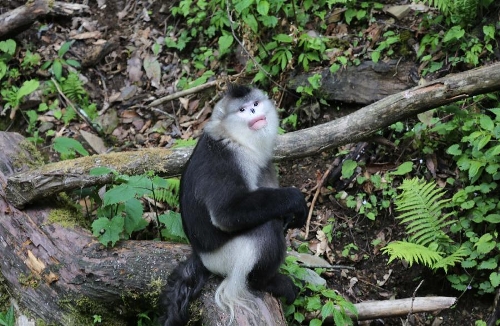Population of Yunnan snub-nosed monkeys grows
Source:Xinhua Published: 2013-5-15 8:49:00

A Yunnan snub-nosed monkey is pictured in the Baima Snow Mountain Nature Reserve, Diqing Tibetan Autonomous Prefecture of Southwest China's Yunnan Province, May 14, 2013. With the steady improvement of local ecological environment, the population of the Yunnan snub-nosed monkeys have reached over 1,000. The monkey, on the country's top protection list, is one of the three types of endangered snub-nosed monkeys which make their home in Southwest China - Sichuan, Yunnan and Guizhou. The Yunnan monkey currently has a population of about 2,000, mainly in Diqing and part of neighboring Tibet Autonomous Region. (Xinhua/Liang Zhiqiang)

A Yunnan snub-nosed monkey is pictured in the Baima Snow Mountain Nature Reserve, Diqing Tibetan Autonomous Prefecture of Southwest China's Yunnan Province, May 14, 2013. With the steady improvement of local ecological environment, the population of the Yunnan snub-nosed monkeys have reached over 1,000. The monkey, on the country's top protection list, is one of the three types of endangered snub-nosed monkeys which make their home in Southwest China - Sichuan, Yunnan and Guizhou. The Yunnan monkey currently has a population of about 2,000, mainly in Diqing and part of neighboring Tibet Autonomous Region. (Xinhua/Liang Zhiqiang)

A Yunnan snub-nosed monkey is pictured in the Baima Snow Mountain Nature Reserve, Diqing Tibetan Autonomous Prefecture of Southwest China's Yunnan Province, May 14, 2013. With the steady improvement of local ecological environment, the population of the Yunnan snub-nosed monkeys have reached over 1,000. The monkey, on the country's top protection list, is one of the three types of endangered snub-nosed monkeys which make their home in Southwest China - Sichuan, Yunnan and Guizhou. The Yunnan monkey currently has a population of about 2,000, mainly in Diqing and part of neighboring Tibet Autonomous Region. (Xinhua/Liang Zhiqiang)

A Yunnan snub-nosed monkey is pictured in the Baima Snow Mountain Nature Reserve, Diqing Tibetan Autonomous Prefecture of Southwest China's Yunnan Province, May 14, 2013. With the steady improvement of local ecological environment, the population of the Yunnan snub-nosed monkeys have reached over 1,000. The monkey, on the country's top protection list, is one of the three types of endangered snub-nosed monkeys which make their home in Southwest China - Sichuan, Yunnan and Guizhou. The Yunnan monkey currently has a population of about 2,000, mainly in Diqing and part of neighboring Tibet Autonomous Region. (Xinhua/Liang Zhiqiang)

A Yunnan snub-nosed monkey is pictured in the Baima Snow Mountain Nature Reserve, Diqing Tibetan Autonomous Prefecture of Southwest China's Yunnan Province, May 14, 2013. With the steady improvement of local ecological environment, the population of the Yunnan snub-nosed monkeys have reached over 1,000. The monkey, on the country's top protection list, is one of the three types of endangered snub-nosed monkeys which make their home in Southwest China - Sichuan, Yunnan and Guizhou. The Yunnan monkey currently has a population of about 2,000, mainly in Diqing and part of neighboring Tibet Autonomous Region. (Xinhua/Liang Zhiqiang)

A Yunnan snub-nosed monkey is pictured in the Baima Snow Mountain Nature Reserve, Diqing Tibetan Autonomous Prefecture of Southwest China's Yunnan Province, May 14, 2013. With the steady improvement of local ecological environment, the population of the Yunnan snub-nosed monkeys have reached over 1,000. The monkey, on the country's top protection list, is one of the three types of endangered snub-nosed monkeys which make their home in Southwest China - Sichuan, Yunnan and Guizhou. The Yunnan monkey currently has a population of about 2,000, mainly in Diqing and part of neighboring Tibet Autonomous Region. (Xinhua/Liang Zhiqiang)

A Yunnan snub-nosed monkey is pictured in the Baima Snow Mountain Nature Reserve, Diqing Tibetan Autonomous Prefecture of Southwest China's Yunnan Province, May 14, 2013. With the steady improvement of local ecological environment, the population of the Yunnan snub-nosed monkeys have reached over 1,000. The monkey, on the country's top protection list, is one of the three types of endangered snub-nosed monkeys which make their home in Southwest China - Sichuan, Yunnan and Guizhou. The Yunnan monkey currently has a population of about 2,000, mainly in Diqing and part of neighboring Tibet Autonomous Region. (Xinhua/Liang Zhiqiang)

A Yunnan snub-nosed monkey is pictured in the Baima Snow Mountain Nature Reserve, Diqing Tibetan Autonomous Prefecture of Southwest China's Yunnan Province, May 14, 2013. With the steady improvement of local ecological environment, the population of the Yunnan snub-nosed monkeys have reached over 1,000. The monkey, on the country's top protection list, is one of the three types of endangered snub-nosed monkeys which make their home in Southwest China - Sichuan, Yunnan and Guizhou. The Yunnan monkey currently has a population of about 2,000, mainly in Diqing and part of neighboring Tibet Autonomous Region. (Xinhua/Liang Zhiqiang)
Posted in: Gallery, China